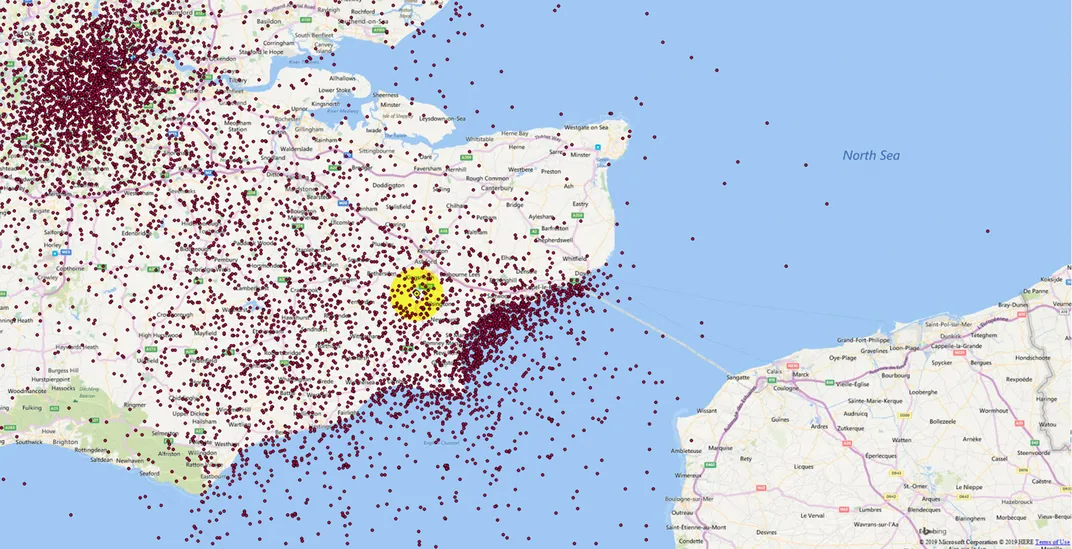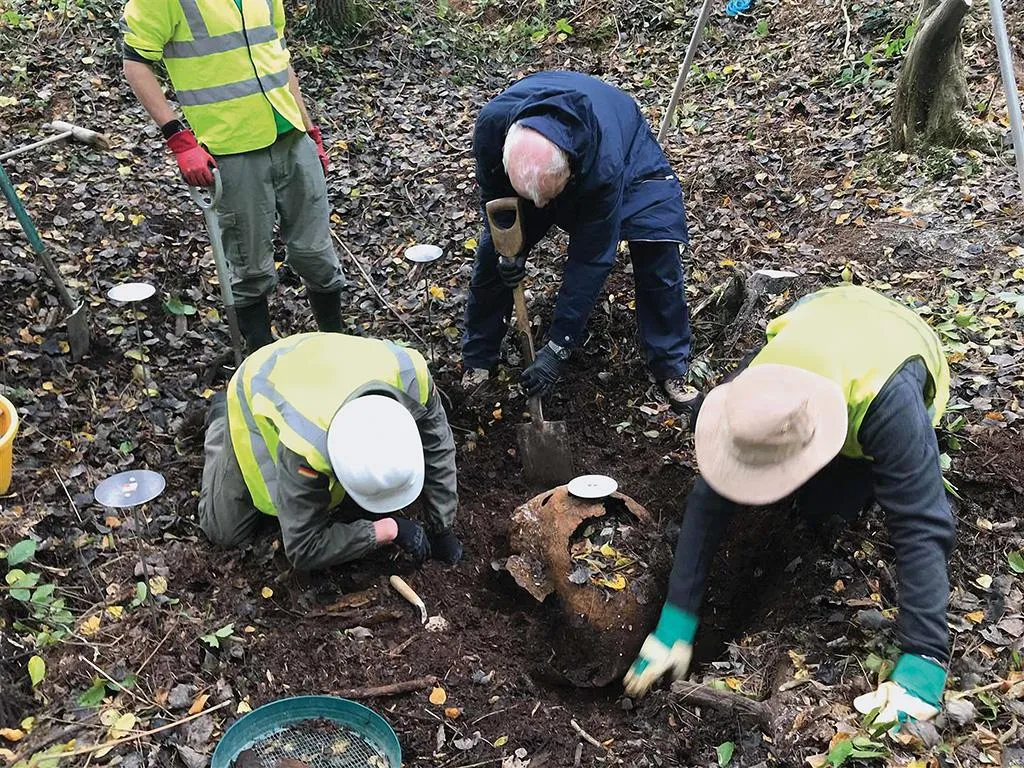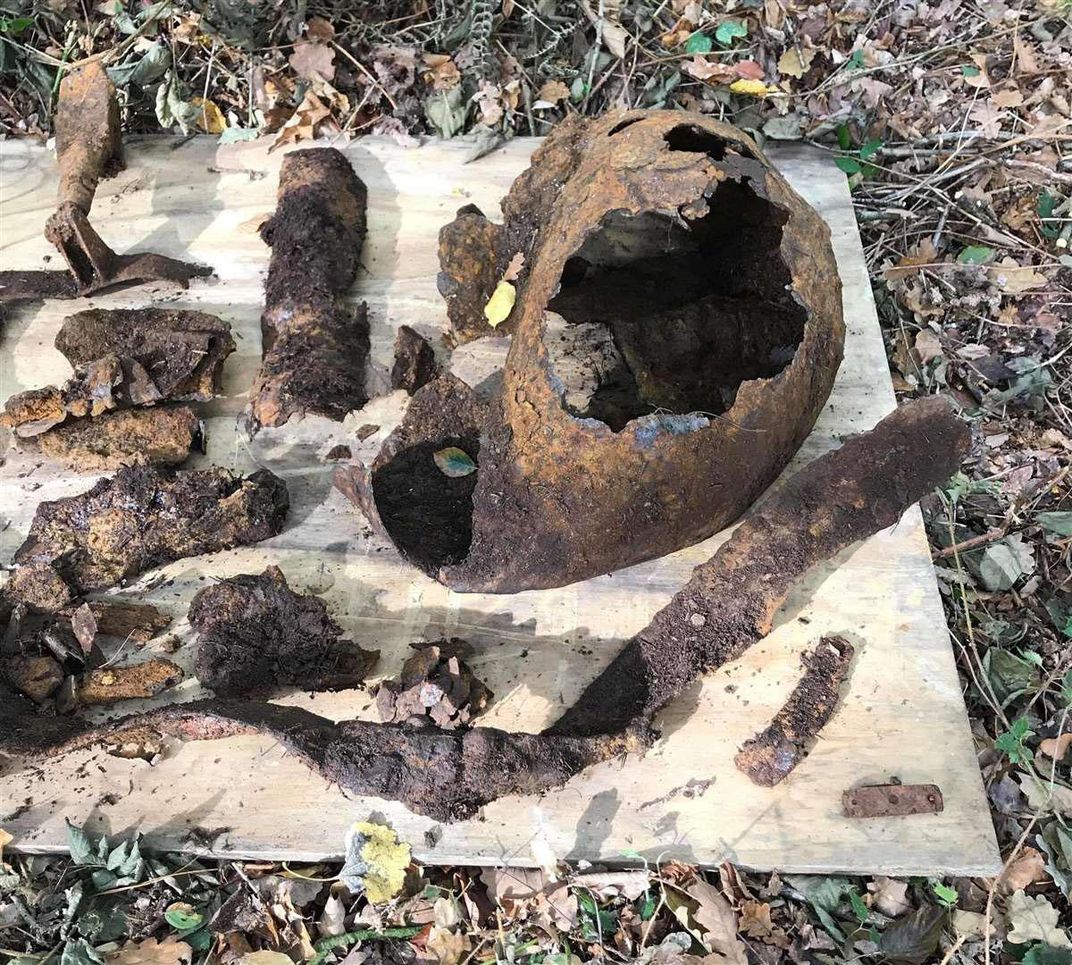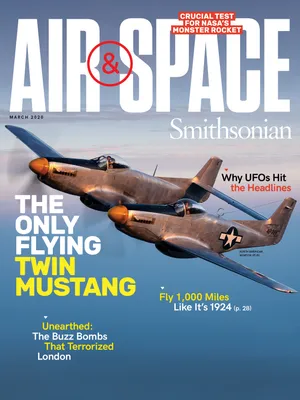These Amateur Archaeologists Dig Up the Buzz Bombs That Fell on England in WW2
Two brothers scour the English countryside for remnants of Hitler’s vengeance weapons.
:focal(2925x800:2926x801)/https://tf-cmsv2-smithsonianmag-media.s3.amazonaws.com/filer/4c/7f/4c7f7ee2-e640-435f-9378-c5534765c5a9/13o_fm2020_colinandseanwelchwithmachine_live.jpg)
This patch of English woodland near the village of Bromley Green, about eight miles from the Channel shore, was once a smoking crater. A V-1 flying bomb—fired by Germany’s Luftwaffe at London but shot down minutes before getting there—crashed and exploded here around eight o’clock in the morning on August 27, 1944, gouging a hole in the earth 10 feet deep and 20 feet across. The blast of its warhead and fuel lifted the nearest house, more than 600 feet away, off its foundations.
Seventy-five years later, to the exact day, the old crater is the site of an archaeological investigation led by two brothers who grew up hearing stories of the terror wrought by Germany’s V-1s. Colin and Sean Welch have searched for fragments of the flying bombs over the past 10 years. Today at Bromley Green, they’ve already cleared away fallen trees and marked out a grid on the surface. A magnetometer scan has found deeply buried pieces of metal—their quarry in the hunt.
The V-1s were the first of the German miracle weapons, Wunderwaffen, that Nazi leaders declared would win the war. Adolf Hitler said they would avenge the Allied bombings of German cities, and they were dubbed V-weapons—Vergeltungswaffen, or vengeance weapons. “Hitler’s was a vengeful personality, always seeking to punish those who crossed him or who betrayed his fantastic ambitions,” says war historian Richard Overy of Exeter University. In a prisoner-of-war camp just outside London, captured German airmen heard the noise of the V-1s. “All the prisoners stood there and started to sing ‘Deutschland Uber Alles,’ ” Welch recalls reading in an historical account. “They all knew that Hitler had promised to win the war at the last minute with the wonder-weapons.”
A V-1 was 27 feet long and weighed more than two tons; its pulse-jet engine was fueled by 165 gallons of gasoline. With a top speed of more than 400 miles an hour, a V-1 could be over England in 15 minutes and over London in 30. A single V-1 carried 1,900 pounds of high-explosive—almost the entire load of a German twin-engine bomber.
“It was a pretty ferocious beast,” says Tom Hopkins, a curator at Royal Air Force Museum Cosford, which displays a captured V-1 flying bomb as well as a V-2 rocket. (The National Air and Space Museum in Washington, D.C. also has both weapons on display.)
The V-1 was guided by a simple autopilot that used three gyroscopes powered by a tank of compressed air. The autopilot kept it flying straight at a height of a few thousand feet, the altitude determined by a preset barometric altimeter. But the launching ramps had to be aimed directly at their targets. A few V-1s trailed aerial wires, broadcasting a regular series of pulses so that the Luftwaffe could calculate when and where they fell. But when the flying bombs were aimed at a large city like London, accuracy didn’t matter much. More than 6,500 V-1s crashed or were shot down by fighters and anti-aircraft guns, but thousands still got through.
When a V-1 neared its target, a counter driven by a small propeller jammed the elevators down and locked the rudder in neutral, putting it into a steep dive, which disrupted the flow of fuel and stopped the engine. The moment the engine sound stopped, the bomb was on its way, and British citizens learned that about 10 seconds after the silence began, the bomb would hit—a desperate time for anyone nearby.
“You just prayed that they wouldn’t cut out and they wouldn’t fall on you. It was a horrible feeling but you prayed, ‘Please let them go further and fall on somebody else…’ ” said a mechanic, quoted in the book Terror from the Sky: The Battle Against the Flying Bomb by British journalist Graham Thomas.

The brothers locate the crashed V-weapons by examining county and national records, including the official “bomb census”—an attempt by the wartime authorities to record the damage caused by falling bombs. Because those records are incomplete, they also check combat reports from fighter pilots on V-1 patrols.
The brothers work closely with historical officers for the county of Kent and send a copy of the final report from each dig to Britain’s Ministry of Defence. They make a detailed risk assessment at each site before a dig begins. Sean explains that V-2s hit the ground at three times the speed of sound, so there is little chance that any unexploded warhead remains. He continues: “The V-1 on detonation leaves a characteristic crater, so when we see this, we know that it has exploded.”
This latest excavation is extremely muddy. The hole fills with water, which must be pumped away. Colin, inside the crater, digs with a trowel, scanning for fragments with a metal detector and directing the shovel of a mobile excavator. As scoops of earth are deposited beside the crater, Sean re-scans them with another metal detector. Every small piece of metal from the V-1 blast will be cleaned, conserved, and photographed for the final report on the dig, to be filed with Kent’s historical records office.
Wartime spy reports gathered by a program codenamed “Operation Crossbow” had warned the British that new German weapons were coming, and aerial photographs had revealed their strange launching ramps along the French coast. But the British weren’t sure what they were up against until the first V-1s started to fall.
Both the pilots and the gun crews quickly learned that the V-1s were traveling too low and too fast to be easily hit. Some of the guns opened fire on V-1s while they were still being chased by warplanes, sometimes resulting in “friendly fire” incidents and a few fatalities. “The AA [anti-aircraft] guns were supposed to stop firing once they picked up any fighters chasing the V-1s, but in many cases they didn’t and some good experienced pilots were lost because of it,” says Thomas.
The high speed of the flying bombs made it almost impossible for most aircraft to catch them. Fast fighters like the latest Spitfires, Tempests, and American-built Mustangs and Thunderbolts were modified for maximum speed by stripping off everything that wasn’t needed—including armor and paint—and souping up their engines. Typhoons, Mosquitoes, Beaufighters, Fireflies, and American Black Widows were also pressed into the air fight against the V-1s, as were a few new Gloster Meteors, the only Allied jets that fought in combat during the war. They were fast enough but had trouble with their cannon.

A few days later, in a workshop filled with intricate metal parts recovered from V-1 and V-2 impact sites, Colin Welch confirms a strange account in the wartime records: a Mustang pilot claimed only half a kill for bringing down the V-1 newly excavated from Bromley Green. “You’ve got the Mustang flying behind the V-1, going full speed to try and catch it up,” he says. “But then a Hawker Tempest swooped in from the front quarter and below and shot at the thing.” Corroded ammunition strikes show the Mustang’s machine gun bullets hit the jet tube directly from behind, but the Tempest’s 20mm cannon also hit the front of the engine. “They both got it, and the archive record is actually right—half a kill for each of them,” he says. “But it is absolutely astonishing to get the evidence in a day’s excavation.”
So far the Welch brothers have found only those V-1 and V-2 impact sites where the warhead and leftover fuel have detonated in a final explosion. Many steel parts have now rusted away, but they often find pieces of the control mechanisms and fuel system that were made from aluminum. A V-1 impact site at Packing Wood in Kent last year was especially fruitful—it yielded much of the flying bomb’s control compartment, which showed where several bullets from the attacking aircraft had hit it.
This latest dig has not yielded all that it might, however. Many of the metal parts usually found at V-1 crash sites are missing from this investigation, including pieces such as the gyroscopes and control mechanisms. Colin suspects treasure hunters known as “nighthawks” have already been over the crater with metal detectors to find trophies for themselves or to sell on the internet. V-1 impact sites are often in woodlands or in the countryside far from any buildings, so the treasure hunters can avoid getting permission from a landowner by not asking for it in the first place. They also avoid making their finds public and documenting them. It’s an activity Colin is firmly against. “They are marauding all of the sites, and there is no record being kept for the future,” he says.

Allied aerial bombing also helped efforts to put an end to the threat of the V-1 flying bombs and the much faster V-2 rockets, which Germany started launching in September 1944. “Overrunning the [launch] sites helped, but it was really Allied air power that made a difference, by disrupting transport and attacking the sources of manufacture,” says Overy.
Colin and Sean Welch are already planning to excavate another V-2 crash in Kent, and there are thousands more V-1 crash sites yet to be uncovered. The brothers hope to create an online museum where 3-D photography of their finds and the history of the V-weapons can be presented. They would like some of the recovered parts of the bombs to be displayed in brick-and-mortar museums.
Finding new financial backers for their excavations is becoming a priority. All their excavations so far have been largely self-funded. “Nothing can help our work more than financial help,” says Colin. He’s also searching for witnesses to V-1 and V-2 impacts to learn more about what they saw of the V-weapon bombing campaigns. “The generations who experienced this thing happening are still amongst us but are dying out fast,” he says. “I need to be talking to them. I need to be knowing where things happened, and recording where things happened for the future.”
In the meantime, the brothers intend to keep digging.
/https://tf-cmsv2-smithsonianmag-media.s3.amazonaws.com/filer/3d/54/3d541f8f-aeed-4f2d-b025-47e53cfc550c/13a_fm2020_v1andspitfiremaybefinalsize_live.jpg)
/https://tf-cmsv2-smithsonianmag-media.s3.amazonaws.com/filer/f1/c3/f1c3da7d-c116-4784-bacb-ff7212e8bdb7/13j_fm2020_v1attackfinalsize_live.jpg)
/https://tf-cmsv2-smithsonianmag-media.s3.amazonaws.com/filer/49/6c/496c7f8e-5882-4f37-b12d-f55be10ea8d6/13l_fm2020_v1crew_live.jpg)
